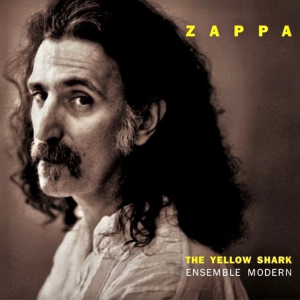 Throughout his entire career, all Frank Zappa wanted was to work with a collective that was not only capable of playing his more sophisticated musical pieces, but enthusiastic about doing so, and willing to help finance them to fruition. In 1991, he found one in Ensemble Modern, a Frankfurt-based outfit that dove into the challenge. Compositions old and new were arranged and tweaked, culminating in a series of concerts entitled The Yellow Shark. An album culled from these shows was released one month before Zappa succumbed to prostate cancer.
Throughout his entire career, all Frank Zappa wanted was to work with a collective that was not only capable of playing his more sophisticated musical pieces, but enthusiastic about doing so, and willing to help finance them to fruition. In 1991, he found one in Ensemble Modern, a Frankfurt-based outfit that dove into the challenge. Compositions old and new were arranged and tweaked, culminating in a series of concerts entitled The Yellow Shark. An album culled from these shows was released one month before Zappa succumbed to prostate cancer. As his classical-type albums go, it’s enjoyable unless you don’t like classical-type albums. Following a brief introduction by the composer (who was too sick to do much of the actual conducting) they go into “Dog Breath Variations” and “Uncle Meat”, both also familiar from previous orchestral excursions. “Outrage At Valdez” was written for a Jacques Cousteau documentary about the Exxon oil spill in 1989, and is suitably grave; along the same lines, two different pieces called “Times Beach” refer to a different chemical emergency that affected ordinary folks. One of the more daring pieces is “The Girl In The Magnesium Dress”, originally composed and played on the Synclavier but here executed by actual people who could replicate the sound of cats running up and down piano keyboards and vibraphones simultaneously. “Ruth Is Sleeping” had a similar birth, but is slightly more musical. “Be-Bop Tango” gets a chance to breathe without the choreographed distractions of the Roxy era.
The four movements from “None Of The Above”, a string quartet originally written for and performed by the Kronos Quartet, appear in a different order than supposedly written, and aren’t immediately melodic. Because he never wrote a skit he didn’t want to perform, this album has two. “Food Gathering In Post-Industrial America, 1992” is recited by a female viola player, punctuated by the sounds of mechanical sewage; then the federal customs form is the basis for “Welcome To The United States”, read in a thick German accent with comical vocal and instrumental responses from the band. (“Louie Louie” makes an appearance.) It’s followed by “Pound For A Brown” and “Exercise #4”, another Uncle Meat refugee. Despite its title—derived from an early version that used only the white keys on the piano—“Get Whitey” is very melodic and almost pretty. Finally, “G-Spot Tornado” is another Synclavier piece newly arranged, and it’s excellent. Still, it would be nice to have something after the nearly two-minute standing ovation at the end.
 The Yellow Shark would not be the last major work he completed before his death, but it certainly got a lot of attention. For several years his estates teased a sequel of sorts; when Everything Is Healing Nicely finally appeared, it turned out to be something of an “audio documentary” of the ensemble’s earliest rehearsals and experiments with him. Moreso than The Yellow Shark, it’s generally for completists, beginning as it does with “Library Card”, mostly recited in German with Lumpy Gravy-style accompaniment. (“Master Ringo” and “Wonderful Tattoo” use a genital piercing enthusiast magazine for their lyric sources.) Luckily, the rest is a lot less silly.
The Yellow Shark would not be the last major work he completed before his death, but it certainly got a lot of attention. For several years his estates teased a sequel of sorts; when Everything Is Healing Nicely finally appeared, it turned out to be something of an “audio documentary” of the ensemble’s earliest rehearsals and experiments with him. Moreso than The Yellow Shark, it’s generally for completists, beginning as it does with “Library Card”, mostly recited in German with Lumpy Gravy-style accompaniment. (“Master Ringo” and “Wonderful Tattoo” use a genital piercing enthusiast magazine for their lyric sources.) Luckily, the rest is a lot less silly.
“This Is A Test” is a brief experiment that deserved to be further developed, while “Jolly Good Fellow” is a conducted improvisation that plays on that familiar melody. “Roland’s Big Event/Strat Vindaloo” is a clarinet solo followed by Frank duetting on guitar with L. Shankar. “T’Murshi Duween” is a Roxy-era piece that usually followed “Penguin In Bondage” and would have been very well received at the shows. The appropriately titled “Nap Time” is based around the Alpine horn while two Japanese poems are recited quietly in the background. “9/8 Objects” features more L. Shankar, and “Naked City” is something of a guitar concerto (not played by Frank). “Whitey (Prototype)” is a brief rehearsal, while “None Of The Above (Revised & Previsited)” juxtaposes a rehearsal with live performance. “Amnerika Goes Home” also comes from the concerts, being an arrangement of a Synclavier piece used as bedding on Thing-Fish.
Between the two albums there is some very enjoyable music showing another side of Frank, but one must endure some of his more idiosyncratic tendencies to get to them. It’s a shame the collaboration didn’t get to go further.
Zappa/Ensemble Modern The Yellow Shark (1993)—3
Zappa Everything Is Healing Nicely (1999)—3
Very nicely done. I always thought that Zappa really wanted us to hear Yellow Shark (as well as his other orchestral work), maybe even more than his rock.
ReplyDelete